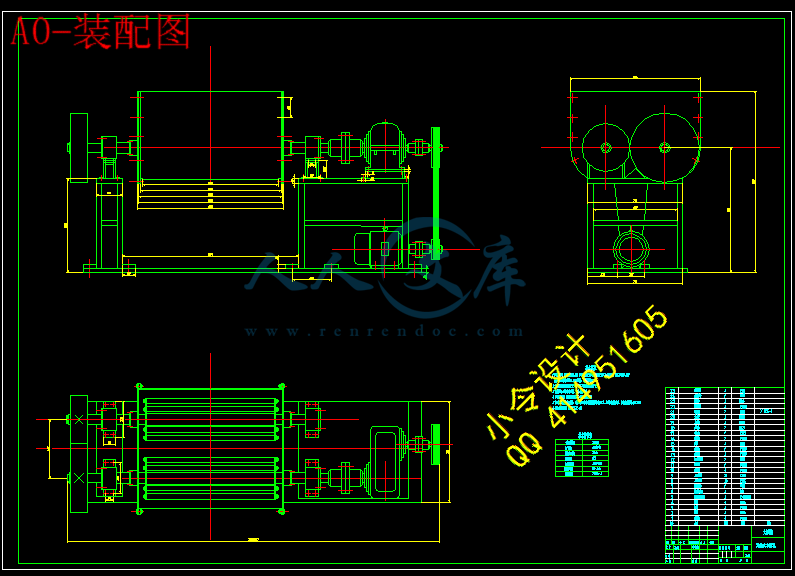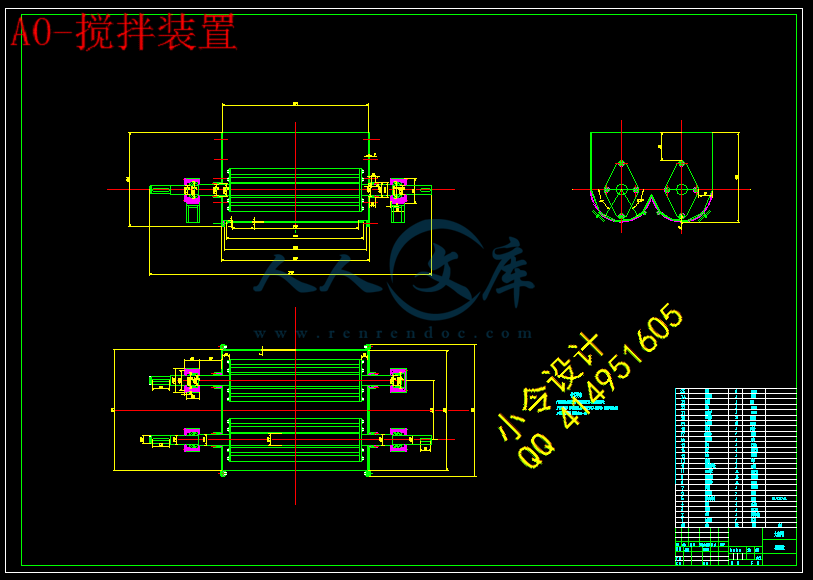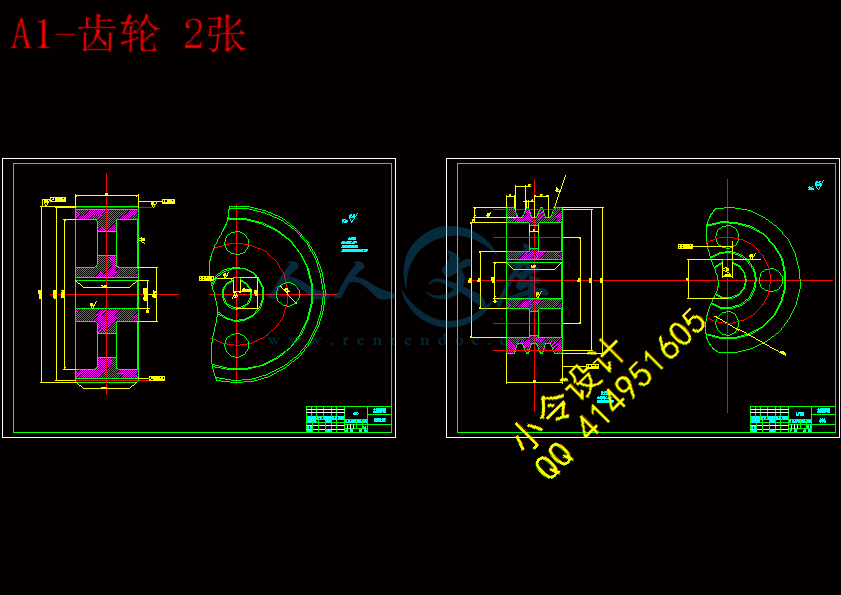摘 要
本文先叙述了方便面的历史与起源,大概分析了一下它的巨大前景。对方便面的生产流程有了初步认识,包括方便面的配料、生产概况、工艺流程、制作方法及整条产品生产线,特别重点研究设计了在方便面生产线中起到关键作用的和面机,包括和面机的工作原理、分类、各类结构组成、操作要求和方法、常见故障和排除方法、和面机的维护和保养、以及和面机的技术要求。自己独立设计的和面机为双轴式卧式和面机,该机一次调粉量为125kg,适合各种韧性面团。它的设计是参照国产的T—66型卧式和面机,主要特点是选择了滚笼式搅拌器,带轮与齿轮传动系统,标准减速箱减速等。与T-66型卧式和面机不同的是,该机器卸料是采用的底部卸料装置,两个搅拌桨相向搅拌,且具有不同转速,达到良好的搅拌效果。该和面机的筒体容器还采用了可卸装置,方便安装与拆卸,对和面机的清洗与保养起到一定作用。本次设计画出了和面机设备总装图,部分重点零件图及部件图。结构简单,制造成本低,适用于大小方便面生产产家。
关键词:方便面;和面机;双轴式
Abstract
This papers first give an account of the history and origin of instant noodles, t analyzing its huge future prospects. For instant noodles ,I have an initial understanding of the production process, including the burden of instant noodles, ingredients, production profiles, processes, production methods and the whole production line, especially,I designed the kneading machine which plays a key role in the instant noodle production line, including working of theory the dough machine works, the categories of the composition, operational requirements and methods, common problems and troubleshooting, and aegis of kneading machine, as well as the technical requirements. The kneading machine I designed by myself is axis horizontal machines., This machine can mix dough by 125 kg one time, suitable for all kinds of toughness dough. It is designed to be refer T-66 kneading machine, the main characteristic is to choose a roll cage mixers, drive system of strap and gear, standard reducer and so on. To be different for T-66 kneading machine ,this kneading machine uses a equipment at the bottom for unloading, using two opposite impeller mixing, and with different speed, to achieve a great mixing effect. The container of the machine can be unloaded easily, play a role in cleaning and maintenance. The design drawn Assembly drawing of equipment, some key parts diagram and parts diagram. Simple structure and low cost of this kneading machine is suit for the every production capacity of instant noodles.
Key words: instant noodle; kneading machine; double-spindle
目 录
摘 要III
AbstractIV
目 录V
1 绪论1
1.1 本课题的研究内容和意义1
1.2 国内外的发展概况2
2 方便面加工系统3
2.1 油炸方便面的起源3
2.2 油炸方便面的工艺流程3
2.3 油炸方便面制作方法3
2.4 质量标准4
2.5 方便面加工装备规格4
2.6 方便面生产线成套设备4
3 双轴式和面机设计5
3.1 设计参考5
3.1.1 和面机调制基本过程5
3.1.2 和面机分类5
3.1.3 和面机的主要零部件8
3.2 设计步骤11
3.2.1 选择和面机容量11
3.2.2 总体方案设计11
3.2.3 运动参数设计13
3.2.4 动力参数设计16
3.2.5 其它装置设计17
3.2.6 设计图17
4 和面机操作及故障分析21
4.1 和面操作要求21
4.2 和面操作方法21
4.3 和面机常见故障及排除方法22
5 和面机的维护和保养23
5.1 机器设备保养的意义23
5.2 机器设备保养等级的划分23
6 和面机的技术要求25
6.1 一般技术要求25
6.2 工作条件25
6.3 使用性能25
6.4 主要零部件质量要求25
6.5 装配要求26
6.6 整机性能27
6.7 电动机功率与耗电量27
6.8 电气27
6.9 外观要求27
7 结论与展望28
7.1 结论28
7.2 不足之处及未来展望28
致 谢29
参考文献30
1 绪论
1.1 本课题的研究内容和意义
方便面自1958年成立以来,经过近五年的发展,已成为世界第二大主食面包方便产品后。在20世纪70年代,中国的方便面的生产技术和设备进口。目前,方便面行业在该国的粮食总产为原料的工业加工食品46%的份额,大大提高了粮食,蔬菜和香料,如水产养殖,加工等行业。方便面,因为它的方便,可口,价格低廉的特点,深受消费者的喜爱,经过30多年的发展,已成为中国食品行业是一个重要的行业,没有既有效地促进中国的主食食品工业化的过程,但也导致中国的农业和农村经济的发展。随着经济和社会的快速发展,人民生活水平的提高和消费需求的变化,中国的方便面行业也面临着前所未有的机遇和挑战。
近年来,中国的方便面生产量不断增加。在中国的方便面生产于1997年,只有14.73亿包,2000年,全国方便面产量达到19.15十亿包,随后快速增长,2004年达到创纪录的48亿包的最大。 2005年,中国的方便面生产波动,略有下降,但仍维持在超过40亿包为43.86亿包。 2006年和2007年全国方便面生产实现持续增长曲线呈迅速上升。 2006年更是达到46亿包,年均增长15.7%,总产量已超过全球总产量的50%。 2007年,至48.9亿包方便面生产,走出了低谷,比2006年增长4.73%,自2004年以来,占世界总产量的1/2。 2007年中国方便面行业经历了很多事件,以实现更快速的增长,得益于中国传统饮食文化的吸纳行业,得益于一体化的产业创新和产品差异化战略的实施。 2007年全国方便面行业将继续扩大产能,产能扩张显着增强的竞争力的企业。我们的即时面条行业,并逐渐形成了一个康师傅,统一,日清,今麦郎,白象,斯美塔那的主要企业代表的龙头企业,并有效地支持行业的持续发展和增长,这些公司都仍然抓住机会来进行了整合并扩大产能。据不完全调查显示,在2007年全行业的新生产线19,只有康师傅增加了11,生产能力已进一步改善。包装的方便面,调味料品种更加多样化,有力地推动了整个行业的发展。包装袋从最初的发展到杯,碗。已经集中在中国传统饮食文化的基础上本地风味的汤方便面产品进入更多的文化内涵,增加品种和营养方便面。调料调味粉包从单一品种,发展石油,酱包,袋等脱水蔬菜,多元化趋势明显增强。目前,中国每年率自然选择的面条品种和新品种上市率约1%至5%,方便,可口的营养和安全过渡时要注意,营养,特定类型的方便面和其他新产品的重点正在出现[2]。
近年来,中国的方便面消费量也不断上升。从1997年到12.55十亿人民币在2007年以35.7亿人民币,同比增长近2倍。截至2004年底,中国的总销售方便面达29亿美元,同比增长34%。 2005年,全国27.57十亿元的方便面销售下降,2006年全行业销售收入实现快速增长,并超过3亿元人民币大关为31.05十亿多元,居世界第一。 2007年,全国销售方便面,实现了巨大的突破,达到35.7十亿亿元,同比增长25.67%。据估计,未来五年,中国的方便面行业将继续增长在10%左右。从包装的角度来看,袋装面的销售额占周围整个行业的比例为74%,其销售额占了较大的比重,,后跟的容器安装面,占国内生产总值的约26%。全球销售方便面,方便面消费的发展相对缓慢,人均消费量相对较小相比,仍有很大的提升空间。目前,人均消费南韩国达到了80包方便面在日本达到了40包,而中国在2007年,只有27个有每年人均消费包(根据国家的1300万人口,下同),差距是非常明显的。如果我们的人均消费水平达到30包,年销售39亿包方便面,如果人均达到了35包,年销售额达45.5亿包,这个数字比2007年增加销售方便面27%,几乎相当的生产量;那年人均消费达到35包,现有的生产正好迎合了消费者。因此,对于我们的方便面行业,仍具有巨大的发展潜力。
1.2 国内外的发展概况
我国原来方便面生产工艺和设备基本上是沿用日本的一套,设备主要引进台资设备,近来国内技术大为改进,出现了大型设备,可靠性也有一定提高,此类产品价格较低,且具备了基本生产性能,占据了国内的绝大部分市场。但是国内生产设备在压延的稳定性、同步控制,以及油温的稳定性的关键环节上缺陷较多。中国的生产设备制造技术已经得到很大的提高,但是,我们要学习日本厂家那种不断更新与改善生产技术以提高产品品质与生产效率的精神。厂家要在注重销售的同时,把精力放在培养现场生产技术人员与品质管理人员的水平提高方面。技术是企业的精髓,我们中国企业缺少的就是技术的扎根与提高。同时设备厂家也应把日本设备及生产技术引进的同时,加快速度在技术进步与提高方面投资,不断为方便厂家的发展提供更新更有效率的设备[3]。
和面工艺是将水和面粉以一定比例进行混合,在一定时间内使面粉充分吸收水分,形成质地均匀、达到理想状态的面团。和面是加工方便面的一道关键操作,其混合好的面团质量直接影响到食品的品质。本课题的任务是要求确定出方便面的加工工艺和生产线配置(生产能力:5万包/班),并对生产线中的关键设备——面粉混合设备进行重点设计,满足半流体状的面团在较短的时间内进行均匀混合的要求。通过本课题的设计,有助于学生能掌握和运用专业知识,锻炼工程设计能力。
随着食品行业的日益发展壮大,生产设备产能变大的要求变得日益强烈。和面机是大多数食品行业必备的生产设备,且一般处在生产流程的上游,和面机的产能,稳定性,对整个生产线来说就显得非常重要。如果单纯靠增加设备的数量,产能虽然可以上去,但是不但设备的费用回大大增加,人力成本和故障率也会增加。
为了很好的解决以上问题,于是大型和面机诞生了。大型和面机自动化程度高,机器故障率低,一个人可以轻松看护两台大型和面机,其产量可以满足大中型食品企业的需求。
2方便面加工系统
2.1 油炸方便面的起源
20世纪最伟大的发明家的食品 - 方便面的发明者五百富(安藤)。
天早二战前后,日本面临严重的食品短缺的情况下,人们都饿甚至吃薯苗。在这个时候,有一上,安藤路过一个拉面条。时间虽然还早,但已经排到了摊前两米长的队伍,人们热切地等待着的凉面锅。拉面摊对面,安藤认为,如果有一张脸,可以吃什么,用开水冲,估计我们想。 1948年,安藤创立中交总社食品公司,开始从事营养学研究。他利用高温,高压将炖熟的牛,鸡骨头的浓汁,营养补充。刚刚上市的产品,他们赢得了日本人的最爱,安藤也因此成为日本食品界的知名人士。生产方便面调味基础的营养补充品的未来发展。天有不测风云,变故使得安藤20世纪50年代,几乎消灭了所有的财产,不得不从头开始创业。然后再次生产的方便面的想法从他的脑子闪过,从那时起,他开始了几十年的方便面了不解之缘。
1958年春天,安藤在大阪,自己的后院房子面积小于10平方米,建立了一个小窝棚,作为方便面实验室。他得到了一个旧制面机,买一个铁锅,直径有1米和面粉,食用油等原料,一头扎进木屋,从黎明到黄昏开始前方便面的出现,所有的实验。面条看似简单的方法,其实原料是非常微妙的,偏巧安藤是一个完全的门外汉,而加入到他的实验了很多困难。他认为所有的东西,他可能已经得到面条机测试,结果做出来的飞机,有些松松垮垮,有的粘球。他没扔,摔它没有。一遍又一遍不厌其烦地重复着。测试让安藤有点痴迷,一次在饭桌上,他的妻子做了可口的油炸食品,他突然学会做一个诀窍方便面:油炸。调和与水面,将分布在油炸过程中水,所以油炸面食表面会有无数的孔,加水煎煮,水像一块海绵一样,表面可以迅速变得柔软。因此,面条蘸在操纵汤的味道,然后油炸干燥,它可以做出来的白开水,可以挽回面子。这种做法是将他称为“瞬间热油干燥法”。因此,最伟大的发明之一出生[4]。
2.2 油炸方便面的工艺流程
一般流程:
精粉,佐料,水——配料——混合——搅拌——复合——压延——蒸煮——油炸——冷却——拣选——加汤料包装——入库
2.3 油炸方便面制作方法
1煎炸油的选择:精炼棕榈油,仿酱,麻油,精制猪油比较最后的审判,成分稳定,酸值低,面色苍白,大部分精炼棕榈油生产建设成本低的选择油。棕榈油作为含不饱和脂肪酸的植物油,可以构成不仅是细胞膜的组成部分和人类前列腺合成的原料,而且,以防止在血管壁胆固醇的沉积;使用棕榈油油炸食品香,味道会变得苍白。此外,花生油在掌心,然后嘴可以帮助消除异味,在生产过程中的麻烦和减轻不适,而且还可以保持手掌苍白,定型角色的特点。
2 对面粉质量的选择:生产产方便面的小麦粉应含有较多的面筋质,采取了将不同品种面粉进行适宜比例搭配使用的方法,然后配用增黏剂,这样便可以弥补了相互间的缺陷,继而增强了面粉的韧性和弹性。这段便可以减少操作过程中落条和短条的现象,产品的光泽度也会很较味理想。
3 汤料口味的改良:
方便面是最受欢迎的开发的主要食物和汤的配方原则,就是要尊重人的地区,饮食习惯和嗜好,包括肉松方便面,方便面和鸡汁调味酱面条等,但它的味道较单一,缺乏香味,口味偏重。一些援助新鲜的调味料,增加成本的基础上增加不大,汤的口味有较大的改善等,味道可口的纯等待,收到良好效果。
4 运输储存:在进行运输时用木箱或竹筐盛装。这样的话应储存于干燥通风处,最主要是不能和有异味的物品存储在同一仓库。还要比较注意的是防潮,防害虫,防霉变,防污染[5]。
2.4 质量标准
1 感官指标:色泽要比较的光亮,透明度也要较好,并且还要有弹性,口感好,口味鲜美并且无杂质,无异味。烹调性好,煮或者泡3~5分钟且不能夹生,无明显断条现象。
2 理化指标:水分占2.35%,酸值(以脂肪的含量算)1.6%,α度约占92.11%,复水时间2~5分钟,盐分含0.94%,含油量占21%,过氧化值(以脂肪含量计)占到0.21%。
3 卫生指标:细菌产生的总数≤30000个/克,大肠杆菌数量≤70个/100克,致病菌(肠道中的致病菌和致病性球菌)的数量不得检出。
2.5 方便面加工装备规格
5万包油炸型方便面所进行的生产线(方形)
产量:50000包/(8h) 型号:BF-5H 蒸汽耗量:1200t/h 装机容量:43kw
耗水量:300kg/h 耗油量:950kg/(8h)
5万包油炸型方便面所进行的生产线(圆形)
产量:50000包/(8h) 型号:WF-5H 装机容量:48kw 蒸汽耗量:1500t/h
耗油量:1000kg/(8h) 耗水量:300kg/h
2.6 方便面生产线成套设备
油炸方便面其中要进行的生产线成套设备一般的话包括:面粉输送机,输送盐水装置,和面机体,喂料机体,连续压片机,复合压片机,蒸熟机,折叠、切割、分排机,油炸机,分配输送机,检查输送机,冷却机,自动包装机,成品输送机。






 川公网安备: 51019002004831号
川公网安备: 51019002004831号